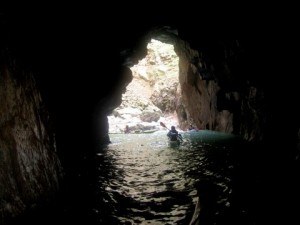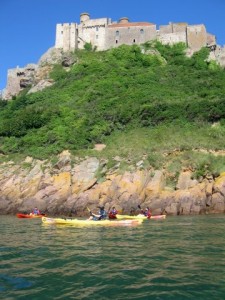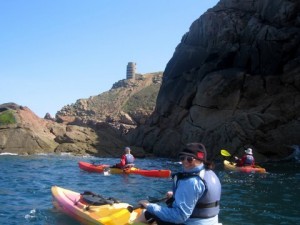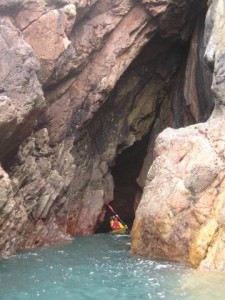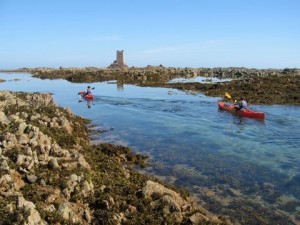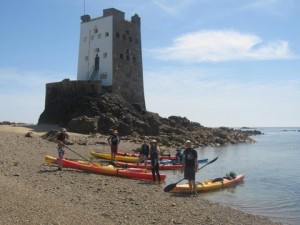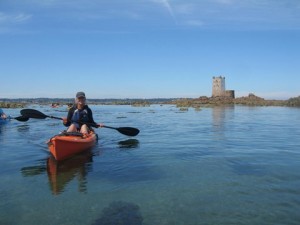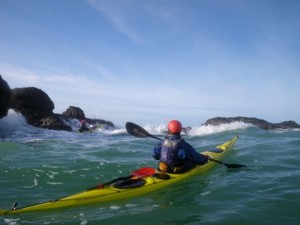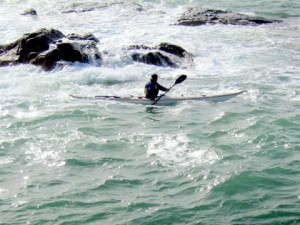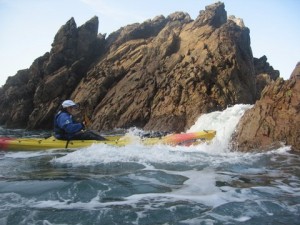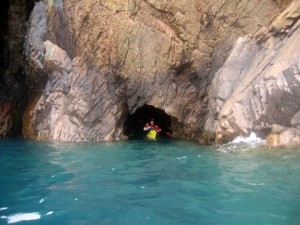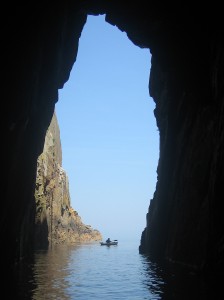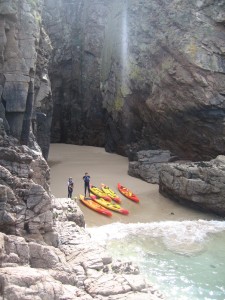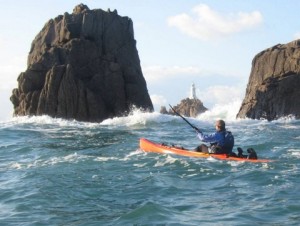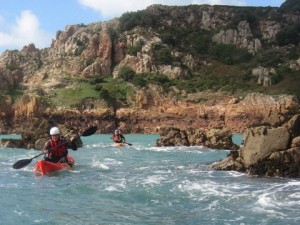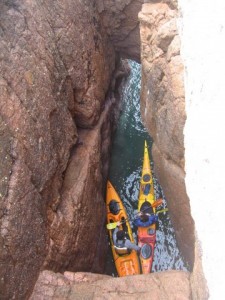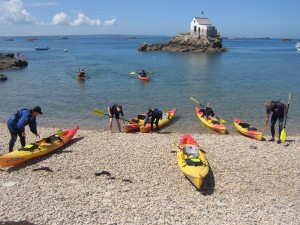Jersey Sea Kayaking Guide
Jersey Sea Kayaking. A guide to the top places to sea Kayak in Jersey
Arrive on Jersey and things look British. The cars drive on the left, the people speak English and all the usual high street retailers are in the capital of St Helier. It all looks rather familiar.
Gradually you begin to notice that things are not quite what they seem. The currency is sterling, but there is a watermark of a cow instead of the Queen on Jersey bank notes. Car number plates carry long numbers and drivers seem to spend most of their time stopping to let people out of minor roads or playing “No, no, after you” at mini roundabouts called filter in turn. The more you look, the more you realise that you are no longer in England.
When you get lost travelling around the island (and “when” is the correct word to use), the labyrinth of lanes is confusing. Stop a local for directions and road names become a verbal challenge, as you try to pronounce the Jersey French place names. I’ll leave you to decide how to pronounce Le Ouaisné or St Ouen. Place names also vary between maps.
Independence and war
Jersey is largely independent from the UK and sets its own taxes. Laws are based on Norman customary law, so do not assume the same laws of the UK – or “mainland” as the locals like to refer to the UK – apply. An example is that local kayakers are legally required to have their contact phone number written on their sea kayak, though visiting paddlers are exempt. This is probably good practice in case you underestimate the speed the tide rises around Jersey and return from a stop at one of the many excellent beach cafés to find your kayak has drifted away.
Though Jersey is geographically much closer to France than the UK, the island is loyal to the British crown. This dates back to Norman times when the Channel Islands became part of the English realm in 1066.
In 1204 King John lost Normandy to the French kingdom. Jersey and Guernsey though remained with the English crown. To all extents the islands were Norman and with Normandy visible on the horizon, it would have been easy to switch sides and join France. The geographical position of Jersey made it a strategic asset whenever England was at war with France. To keep Jersey on the English side King John poured huge amounts of money into Jersey for its defence and granted the island more independence. In return the island became the front line for English forces and a haven for privateers. At every bay and headland you will see 18th and 19th century British fortifications.
In 1940 the Channel Islands were occupied by the Nazis and Jersey quickly became an almost impregnable fortress. All the Channel Islands were more heavily fortified than any other coastal region in Europe and this level of fortification far outweighs the strategic importance of the islands to the Nazis. Around 10% of the entire Atlantic wall defences were constructed in the Channel Islands.
By 1944 an incredible 244,000 cubic metres had been excavated compared to 255,000 cubic metres for the entire Atlantic wall in Europe. The Führer greatly prized the islands in part because he had captured the oldest possessions of the English Crown. Hitler even ordered that all plans for the islands must be sent to him personally for approval. By 1943, 42,800 Germans were based in the Channel Islands – equivalent to two thirds of the civilian population.
Sea kayaking in Jersey
Jersey’s rich maritime history today manifests itself in the vast number of boats moored in the small harbours. For the Jersey-man owning a boat is almost a constitutional right, and as you drive around the island, it seems that if you don’t have a surf board, SUP or kayak on your car or in your garden you’re probably a visitor.
Jersey tides
Jersey has big tides of up to 12.5m. Get your timings wrong and the tide streams will easily send you backwards. On spring tides a rise of up to 3” per minute is common.
That’s not to say that Jersey is only suitable for experienced kayakers. Much depends on selecting the best location based on the wind and tide streams – which is a good reason for the less experienced paddler to get afloat with a local kayak company.
There are plenty of bays and coastline to explore and discover on an island of 45 square miles. If conditions are unsuitable on one coast, it is usually possible to paddle on the opposite side of the island, which is usually only a short drive away. And the big tidal range means, you can paddle a coastline which appears completely different within a few hours . This means the return trips are never boring, and if you time the tide streams right you will get assistance both ways.
Along with a good chart the States of Jersey 1:25,000 map and a copy of the Admiralty tidal stream atlas NP264 are essential items.
Apres paddling
There is a huge choice of accommodation on the island ranging from camp sites to 5 star hotels and lots of other activities and sights to visit when not kayaking. Wild camping and sleeping in camper vans at local bays is discouraged, so you may wish to opt for a hotel, B&B or camp site.
The southeast coast of Jersey
The intertidal zone in the southeast coast is remarkable. Select the right tide and this is literally a paddle on the seabed with many different habitats. Since 2000 the area is an internationally designated Ramsar wetlands site.
During the third hours of a spring tide the rise and fall is around 3” per minute, so on the ebb tide you need to get your timings right, unless you like long portages up the gullies. Alternatively bring a set of kayak wheels with you.
Start at the old lifeboat station in St Helier Harbour. If it is a big low tide, expect to wade through ankle deep harbour mud.
To the north of the Dogs Nest (Le Nic ès Tchians) on a big low tide is the wreck of the SS Diamant (sunk 1942); this reef can be exposed to a south west swell.
Aim 0.5km south of Green Island (3km distant) for La Sambue channel. Initially this looks like a mass of rocks, but you soon notice routes appearing and your speed will increase as the flood tide rushes between the reefs. From now on you will be going with the flow as if on a travelator. This is when river techniques come in handy.
As you cross St Clement’s Bay slipping down gullies like a Mackerel going with the flow, observe the seabed and the jungle of seaweeds (most are edible). The deep water Laminaria releases an iodine like smell; there are records of Laminaria being used as a dressing for wounds during the Nazi occupation.
La Rocque Harbour was the site of the French invasion led by Baron De Rullecourt on 5th January 1781. The British garrison wrongly assumed the treacherous reefs of the Violet Bank would stop any landing. De Rullecourt, however, had local knowledge from a somewhat dodgy character named Pierre Journeaux.
At midnight 26 boats sailed up the main gully, the nine militiamen on guard had been celebrating Twelfth Night, so they were in no fit state to detect the 700 men. The French attack was finally defeated after a brief battle in St Helier.
A metal safety tower (0.75 km east of the harbour) is a good target, as the water will be flowing through dozens of small channels by now. Take care if you climb the tower as the tide rapidly covers the shingle spit.
A detour out to Seymour Tower (1782) is worth doing before the tide gets too high. You can stay over a tide on the parapet. Sleeping inside the tower, which is fitted out with bunk beds and cooking facilities, must be booked in advance with Jersey Heritage or Jersey Walk Adventures. The view is superb and you may see gannets fishing.
If you have time paddle out to Karamé and La Conchière beacons and the Violet Bank. There is a good chance of seeing seals here though you will now be 4 km offshore and tide streams run fast.
From Seymour and La Rocque it is a straight run across La Baie du Vieux Château to the busy harbour village of Gorey with plenty of places to eat and enjoy a pint.
Oysters galore
Until 8000 years ago it was possible to cross to France on foot. As the sea rose shallow lagoons formed off the east coast of Jersey, which were perfect for oysters. In the 19th century oyster fishing developed into a huge industry. This led to the construction of most of the small Harbours around Jersey at an average cost of between £2500-£3000 per Harbour.
The high levels of extraction were unsustainable and the oyster stocks had collapsed by 1872.
Gorey to Bonne Nuit Bay
From Gorey a north going stream runs between Le Nez du Château rocks beneath Mont Orgueil castle. Few people get the chance to see the castle from this angle, so it is worth looking up, while you try a few ferry glides.
Instead of paddling directly to St Catherine’s breakwater follow the coastline, which is best paddled around high tide. Archirondel Bay marks the start of the Rozel Conglomerate, a product of volcanic eruptions millions of years ago.
The slip at St Catherine is a handy take out and is next to the Jersey Canoe Club boathouse. It’s worth contacting the club in advance for advice and the opportunity to paddle with club members.
Unless you are in a rush, explore the usually deserted bays of Fliquet, La Coupe and Scez as you head to Rozel. The small harbour has long been the departure point for fishermen (and smugglers). Onwards to Bouley Bay the inshore route has many tiny coves to explore. There are also plenty of rock gardens of varying technical levels.
La Tour de Rozel (or White Rock) is a well known tide race and play spot, which works best on the rising tide (east going stream). If the overfalls are big at La Tour they will be even bigger off La Belle Hougue point.
Beneath La Tête des Hougues is the wreck of the SS Ribbledale which ran aground during a storm in 1926 and is visible at low tide. All that remains is the engine and boiler after the ship was broken up for scrap metal.
Le Petit Port or Égypte is a tiny cove with an ancient guardhouse that is maintained by the Jersey Canoe Club as a bothy style accommodation (for hire).
Survival at sea
On 9th October 1964 Jersey was battered by westerly 94 knot winds. During the storm the yacht Mariecelia was found abandoned off Noirmont Point on the south coast. There was no sign of the five people on board and a search ensued.
On the 10th came news that 14 year old Alison Mitchel had survived. Having abandoned the ship one by one her companions drowned. After being swept around Jersey for 18 hours she struggled ashore at Égypte, her body so swollen by the seawater, she could only see by forcing her eyes open with her fingers.
La Belle Hougue and unexploded bombs
Between La Colonbine and La Belle Hougue the coast shows off some fascinating geology and a narrow gully in Les Ruaux can often be paddled.
La Belle Hougue Caves lie in the gully below the viewing point and can be explored on foot in very calm conditions. Take care as you scramble over the rocks as I once found a large unexploded German shell here. Paddling against the stream around Belle Hougue on a big tide is difficult unless you are prepared to handrail the coast and use every tiny promontory as a breakout.
Bonne Nuit
At the entrance of Bonne Nuit Bay Le Chaval Guillaume rocks once formed part of the St John’s day celebrations (24th June). Back in 1792 Phillipe Dumaresq wrote: “For years an old custom has drawn … people to enjoy the insipid amusement of being rowed in a boat around a rock. That done, there is nothing to do but to drink gin and cider.” Dumaresq decided to liven this event up with a two day fair. This became so popular it was closed down by the authorities for being “contrary to good morals”.
Bonne Nuit is the finishing point for the annual Sark to Jersey rowing race. The single seat rowing boats make the 28 km (15 nm) crossing in around 2 hours. Currently sea kayaks are not permitted to enter the race.
Greve de Lecq caves
The harbour is a good example of how things were not always built to last in the past. Constructed in 1872 it collapsed within 13 years. Above the bay though is a late Iron Age promontory fort. The headland is a popular spot for Jersey’s national sport of “cliff jumping” as well as coasteering.
Rounding Rouge Nez are some of the best sea caves in Jersey. Entry to each cave varies depending on the height of tide. Half tide gives some of the best opportunities to explore the caves, some of which are up to 100m deep. Check there is no swell running and keep an eye for sudden changes in swell height unless you fancy some advanced rescue practice.
Look out for lengths of rope and even ladders leading down to rocky ledges along the coast. They are used to access good fishing spots – fishing in Jersey can be an extreme sport.
Beyond L’ île Agois, a small islet with narrow gullies and a sea arch, the cave entrance at La Touraille (Devil’s Hole) is tricky to find. It lies just below the line of the small valley and before the path swings west. Though facing north east there is often a swell inside this cave, which opens into a large amphitheatre complete with tourists looking down on any kayakers. The name Devil’s Hole is reputed to come from when a ship’s figurehead was washed into the cave in 1851. A statue of a devil was adapted from the figurehead by Captain Jean Giffard “Stonemason, self-taught stone-carver, Prison guardian, Master Mariner and reputed smuggler” and erected above the Devil’s Hole as an attraction. The statue was regularly ‘borrowed’ as a prank in the 19th and early 20th century and would reappear outside the local newspaper office in St Helier.
In calm conditions you can approach a small waterfall at the end of La Vallee de Mourriers. Continue round Sorel Point towards Le Cormoran Rock. Nearby is Wolf’s Caves. The unsafe cliff path descent is now closed, but you can land at low tide on the boulders and enter a tiny entrance on the right at base of the cliff. Around half tide it is possible to paddle into the cave system via an entrance between Cotil Point and the boulder beach. 100m further east are some excellent rock gardens known by local paddlers as “The Toilet” because you get flushed through them.
Gros Nez
Head west beneath the cliffs from Greve de Lecq to La Tête de Plémont. Check it is not the Puffin breeding season as a voluntary 100m exclusion zone exists. From a few hundred birds in the 1920’s Puffin numbers have plummeted. It is suspected that this is a result of rats, wild cats and perhaps the arrival of Fulmars, who have colonised traditional Puffin nesting spots.
Le Creux Gabourel is one of the few caves to have a sandy beach. Above the entrance of the cave, wedged into the roof are rounded boulders from when sea levels were 8m higher.
The small cove of Le Petit Plémont (with evidence of boat moorings on the rocks) is a good spot to assess the tide race and swell off La Tête de Plémont. There can be a huge difference in the swell size once you round this headland.
Plémont Bay or La Grève au Lanchon (lanchon the Jersey French name for sand eel) has some caves and a very good café. The beach is completely covered above half tide.
This section of cliffs beneath Gros Nez castle is rarely paddled by local sea kayakers because it is quite exposed and it is rare not to have some swell about. As you approach the sea stack known as La Vie, there is a sea cave with two entrances which can sometimes be paddled. 300m west of Plémont beach (and above sea level) is La Cotte à la Chèvre, where some of the earliest Palaeolithic remains of habitation in Jersey were discovered.
At the base of the cliffs below the Nazi range control tower lie the remains of some heavy artillery guns which are visible at low tide. At the end of the occupation the guns were dumped over the cliff. Some have been recovered and can be seen at Noirmont Battery.
Le Pinacle Rock is an important archaeological site with Neolithic, Chalcolithic, Bronze Age, Iron Age and Roman remains. For more than 4500 years this imposing rock which resembles a huge Menhir (standing stone) captured the imagination of the inhabitants of Jersey as a very special place. A narrow cave runs beneath the headland.
Kayak surfing
La Baie de St Ouën is an excellent surfing beach and it is not until you are near La Pulente that you may find a relatively sheltered landing. In large surf it is a good idea to head inside the reefs towards La Rocco tower and land at La Pulente.
If you are planning on surf kayaking, you are required to have third party insurance such as is provided through BCU membership.
La Pulente and La Corbière
This area has many reef breaks, so you’ll need to keep a close watch on the wave patterns and keep a good distance apart. Victor Hugo (who lived in Jersey 1852–1855) described this area as the ‘herdsman of the waves’. I’ve seen sea kayaks go airborne here, as paddlers frantically dash beyond the swells, and this is also where tow ins (surfers are towed in to catch huge swells by jet ski) may take place …
Landing at the La Corbière lighthouse is tricky, as a tide stream runs over the causeway on both the flood and ebb tides. The causeway is a great spot for ferry glides and overfalls occur off the western end of the lighthouse.
There are numerous shipwrecks in this area, the most recent was the St Malo high speed ferry in 1995 with 307 passengers. The captain was attempting a tricky inshore passage as a short cut. Fortunately all were rescued.
St Brelade heading west
There is a sea stack at Les Jeteuses below Beau Port battery. The gun battery is one of 13 that defended St Brelade bay from French attack. Le Beau Port is a jewel. On a sunny day the bay takes on a Mediterranean feel and often has a few luxury yachts at anchor. The red granite cliffs along this part of the coast have a wonderful warm feeling.
The cliffs continue from Beau Port to La Corbière with many small caves and sea arches that are easily missed, if you stay further offshore. There are a couple of peregrine falcon nests at La Grosse Tête and Trespass point (La Tête) and lots of bird life around Les Leaux de Ficquet.
A little offshore, Les Caînes reef was the site of the grounding of the SS Roebuck in 1911, when travelling in thick fog at 17 knots the steamer ran onto the reef. A subsequent inquiry suspended the somewhat accident prone Capt Le Feuvre’s master’s ticket for only three months even though it was the second time he’d hit rocks off Jersey. In 1897 he’d lost his ticket for six months after the Ibex, which was racing a rival vessel, hit rocks off La Corbière.
Near Point La Moye is a large cave. On the cliff top is a huge hole which some locals recall once worked like a whale spout in storms. You can paddle into this cave, but look out for the swell from passing boats. Inside, you can see the remains of a few old cars that used to be pushed into the hole until the 1960’s. From Point La Moye to La Rosière there are numerous channels and stacks. The granite wall at the base of the cliffs in La Rosière was constructed in Victorian times as a tourist path into the caves.
The large tidal range makes the return trip very different and worthwhile.
The you-can-do-it-here island
With such a huge range of sea kayaking opportunities on Jersey this brief guide has not even covered the offshore routes to Les Écréhous, Les Minquers, Sark and beyond.
Apart from excellent kayaking the small island also offers an astonishing variety of things to do and visit – be it walking, coasteering or explore neolithic dolmen, a mediaeval castle and romantic harbours with inviting restaurants, not to forget friendly shopping precincts.
Add that there are regular high speed ferry links and flights from most regional airports, and you may well be out sea kayaking the Jersey coastline quicker than if you were driving to some “Mainland” paddling destinations.
This article was originally published in Ocean Paddler. View as a pdf.

